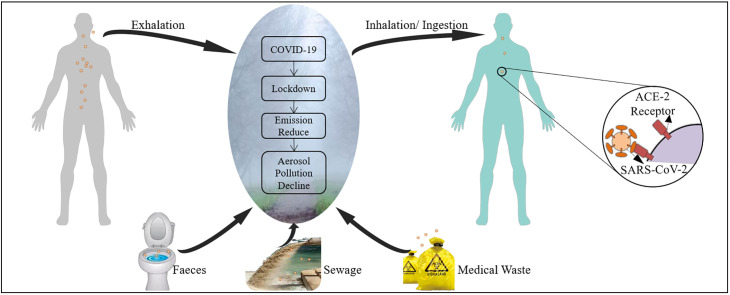- Record: found
- Abstract: found
- Article: not found
Multiple relationships between aerosol and COVID-19: A framework for global studies

Read this article at
Abstract
COVID-19 (Corona Virus Disease 2019) is a severe respiratory syndrome currently causing a human global pandemic. The original virus, along with newer variants, is highly transmissible. Aerosol is a multiphase system consisting of the atmosphere with suspended solid and liquid particles, which can carry toxic and harmful substances; especially the liquid components. The degree to which aerosol can carry the virus and cause COVID-19 disease is of significant research importance. In this study, we have discussed the aerosol transmission as the pathway of SARS-CoV-2 (Severe Acute Respiratory Syndrome Coronavirus 2), and the aerosol pollution reduction as a consequence of the COVID-19 lockdown. The aerosol transmission routes of the SARS-CoV-2 can be further subdivided into proximal human-exhaled aerosol transmission and potentially more distal ambient aerosol transmission. The human-exhaled aerosol transmission is a direct dispersion of the SARS-CoV-2. The ambient aerosol transmission is an indirect dispersion of the SARS-CoV-2 in which the aerosol act as a carrier to spread the virus. This indirect dispersion can also stimulate the up-regulation of the expression of SARS-CoV-2 receptor ACE-2 (Angiotensin Converting Enzyme 2) and protease TMPRSS2 (Transmembrane Serine Protease 2), thereby increasing the incidence and mortality of COVID-19. From the aerosol quality data around the world, it can be seen that often atmospheric pollution has significantly decreased due to factors such as the reduction of traffic, industry, cooking and coal-burning emissions during the COVID-19 lockdown. The airborne transmission potential of SARS-CoV-2, the infectivity of the virus in ambient aerosols, and the reduction of aerosol pollution levels due to the lockdowns are crucial research subjects.
Graphical abstract
Related collections
Most cited references124
- Record: found
- Abstract: found
- Article: not found
Genomic characterisation and epidemiology of 2019 novel coronavirus: implications for virus origins and receptor binding
- Record: found
- Abstract: found
- Article: not found
Aerosol and Surface Stability of SARS-CoV-2 as Compared with SARS-CoV-1

- Record: found
- Abstract: found
- Article: found

